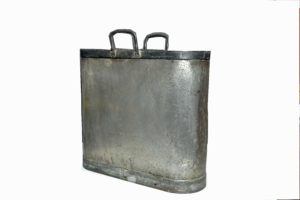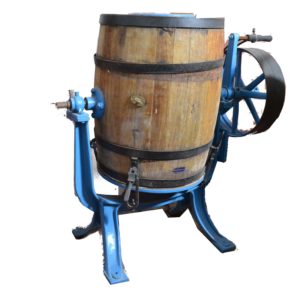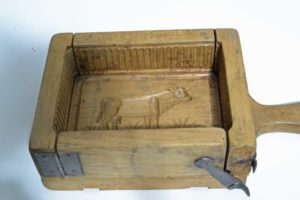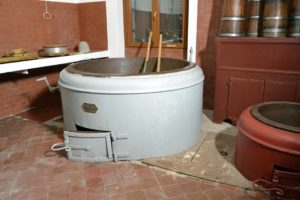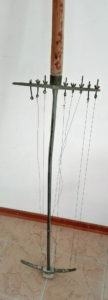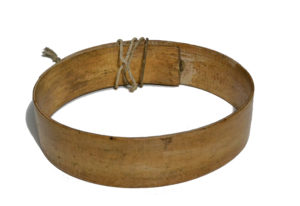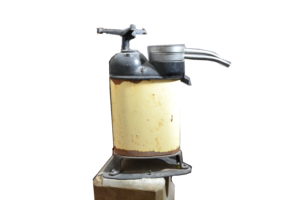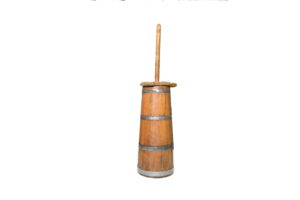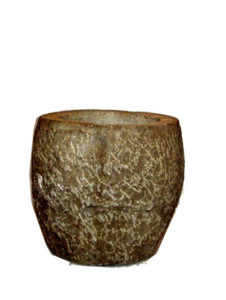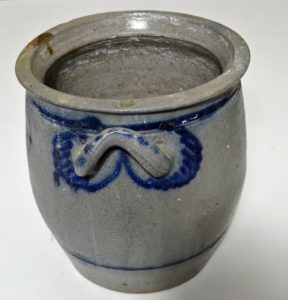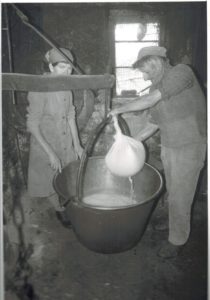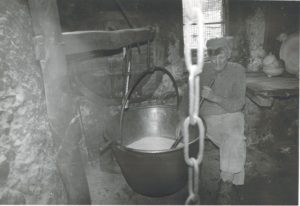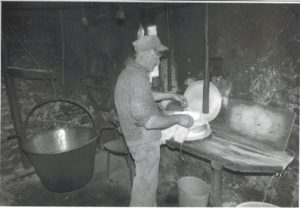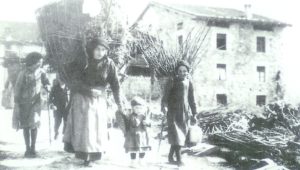The third room is dedicated to the production and processing of milk to obtain cheese, butter, and ricotta cheese.
At the beginning of the 20th century, the valley had eighteen dairies, many of which remained active until 1976, when the earthquake marked a rupture with the worlds of rearing and haymaking.
The cows were milked twice a day: early in the morning, around six, and in the evening at sunset. After the quantity of milk that was needed for breakfast and lunch was put aside, the rest was brought to the social dairy. The farmer brought the milk that needed to be weighed: the dairyman wrote down the quantity of delivered milk in a booklet. Before being weighed, the milk was sometimes analysed to verify that the farmer had not added water to it.
The milk was then filtered with a sieve to eliminate foreign bodies and poured in long and narrow copper containers, which were put in a basin with running water to keep their content fresh. The milk stayed there for at least twelve hours, until the cream surfaced and had to be taken off and put into the butter churn.
The butter churn is a kind of barrel that is placed on a base. The cream was poured into the cylinder through a pipe union which was then closed hermetically. The barrel was then rotated manually by two people, and in more recent years mechanically. Thus the cream was shaken until it became butter.
The butter was then removed and placed in specific moulds with drawings carved on the lid and on the sides. The decorations were different, a cow, a flower, a mountain image, and left and imprint on the butter pats, which weighed half a kilo or 1 kg. The farmers usually collected the butter in the evening, and the quantity that each received was written in the booklet.
Skimmed milk, on the other hand, was poured into a large copper boiler that was actioned by a Swiss cart system: the boilers were fixed while the stove with the fire was movable. After lighting the fire on the movable stove, the dairyman heated the milk until it reached a temperature of 42°C (to test the temperature, he usually immersed a thermometer in the milk). Once the temperature was reached, the dairyman moved the stove by turning a crank and positioned it under the central boiler, the smallest one, which contained some water that was used for cleaning.
The rennet was then added to the heated milk in order to prepare the curd. As the milk coagulated on the surface first, while most of the bottom remained liquid, the dairyman intervened with a big whip, a big rectangular framework that was crossed by strings as thin as harf strings, which allowed to break the surface layer and obtain a homogeneous mass in the whole cauldron.
The product was then heated on the stove again: this cooking phase was completed when a temperature of around 50° was reached. The clot was then extracted with canvases and put in round wooden moulds. The cheese was pressed with a manual press for one day, so that it could take on its characteristic round shape. The next step was the salting in brine. The aging process was then carried out by placing the cheese wheels on some wooden boards to facilitate the completion of fermentation.
In the Alpine farmsteads the butter was prepared by pouring the cream into the butter churn, which was a cylindrical stave container. The lid had a handle and a hole in the middle where the pole of a piston was passed, which at the higher end had a handle that was used to shake, and at the lower end, in the cylinder, had a wooden disk with a diameter slightly shorter than the internal diameter of the cylinder.
Once the cream was poured, the cylinder was closed with a lid and a piston, which was later used to shake it. The transformation into butter required around two hours of continuous shaking.
The butter was put on the fire and melted to prevent it from getting sour, and it could be preserved in cylindrical stone containers with a rounded bottom and a wooden lid, or in terracotta containers.
As far as the preparation of butter in the farmsteads is concerned, once the curd was prepared, it was broken using a rudimental ash stick which had a double fork on the tip, or using a 1.30 m pole with some linchpins of around 10 cm at both ends fastened in all directions. The rennet was prepared at home by drying the stomach of a lamb, kid, or calf.
The Alpine farmsteads were also the place were ricotta cheese was prepared. After the cheese was extracted, the whey remained. The boiler was placed on the fire waiting for the whey to start boiling. As soon as a thick foam formed on the surface, fresh water with some salt or vinegar was poured on the rim. A chemical reaction allowed the ricotta cheese to come to the surface, where it was picked up with a ladle (similar to the spannarola) and then spread on a table. There it was first pressed with the hands to drain the excessive whey, and then flavoured with salt and grains of pepper. To foster its preservation, ricotta cheese was pressed into some stone containers and covered with corn leaves that had been drenched in water.
The multimedia installation presents some videos regarding:
- Homemade milk processing by the last dairyman in the valley, Albino Micottis
- Life in the Alpine farmstead of Chisalizza/Kisalica, recounted by Valenzio Culetto
- The Pust tradition, the Carnival that is still alive in the village of Micottis. In the past, for the entire duration of the Carnival, people gathered to prepare dresses, dialogues, scenes, and competed in who was the most engaged in making the last day of Carnival unforgettable, at least for the next year. All the disreputable things that had happened or were believed to have happened in the villages during the past year, were recalled, brought up, performed with live acts. In the Upper Torre Valley, these scenes were performed in the squares, in the Cornappo Valley they were staged in the most capacious houses.
- The Pust tradition, the Carnival in Cergneu
- The Bonfires of Saint John in Musi.

